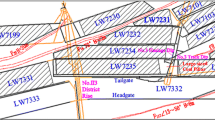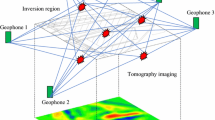Abstract
In order to quantitatively evaluate the relationship between the tomographic images of P wave velocity and rock burst hazard, the seismic velocity tomography was used to generate the P wave velocity tomograms during the retreat of a longwall panel in a coal mine. Subsequently, a novel index (bursting strain energy) was proposed to characterize the mining seismic hazard map. Finally, the structural similarity (SSIM) index in the discipline of image quality assessment was introduced to quantitatively assess the relation between the bursting strain energy index images and the tomographic images of P wave velocity. The results show that the bursting strain energy index is appropriate for quantitative analysis and seems to be better for expressing the mining seismic hazard than the conventional map. The SSIM values of the future bursting strain energy compared with the P wave velocity and the current bursting strain energy reach up to 0.8908 and 0.8462, respectively, which illustrate that the P wave velocity and the bursting strain energy both are able to detect the rock burst hazard region. Specifically, seismic velocity tomography is superior to the bursting strain energy index in the detection range and the precision and accuracy of detection results.





Similar content being viewed by others
References
Amitrano D (2012) Variability in the power-law distributions of rupture events. Eur Phys J Spec Top 205:199–215. doi:10.1140/epjst/e2012-01571-9
Bańka P, Jaworski A (2010) Possibility of more precise analytical prediction of rock mass energy changes with the use of passive seismic tomography readings. Arch Min Sci 55:723–731
Benioff H (1951) Crustal strain characteristics derived from earthquake sequences. Trans Am Geophys Union 32:508–514
Bräuner G (1994) Rockbursts in coal mines and their prevention. AA Balkema, Rotterdam
Dou L, Chen T, Gong S, He H, Zhang S (2012a) Rockburst hazard determination by using computed tomography technology in deep workface. Saf Sci 50:736–740. doi:10.1016/j.ssci.2011.08.043
Dou L, He J, Gong S, Song Y, Liu H (2012b) A case study of micro-seismic monitoring: goaf water-inrush dynamic hazards. J China Univ Min Technol 41:20–25
Dou L, Cai W, Gong S, Han R, Liu J (2014) Dynamic risk assessment of rock burst based on the technology of seismic computed tomography detection. J China Coal Soc 39:238–244. doi:10.13225/j.cnki.jccs.2013.2016
Eberhart-Phillips D, Han D-H, Zoback MD (1989) Empirical relationships among seismic velocity, effective pressure, porosity, and clay content in sandstone. Geophysics 54:82–89. doi:10.1190/1.1442580
Filimonov Y, Lavrov A, Shkuratnik V (2005) Effect of confining stress on acoustic emission in ductile rock. Strain 41:33–35. doi:10.1111/j.1475-1305.2004.00182.x
Frankel A (1995) Mapping seismic hazard in the central and eastern United States. Seismol Res Lett 66:8–21. doi:10.1785/gssrl.66.4.8
Frankel A et al (2000) USGS national seismic hazard maps. Earthq Spectra 16:1–19. doi:10.1193/1.1586079
Friedel M, Jackson M, Scott D, Williams T, Olson M (1995) 3-D tomographic imaging of anomalous conditions in a deep silver mine. J Appl Geophys 34:1–21. doi:10.1016/0926-9851(95)00007-O
Friedel M, Scott D, Williams T (1997) Temporal imaging of mine-induced stress change using seismic tomography. Eng Geol 46:131–141. doi:10.1016/S0013-7952(96)00107-X
Gilbert P (1972) Iterative methods for the three-dimensional reconstruction of an object from projections. J Theor Biol 36:105–117. doi:10.1016/0022-5193(72)90180-4
Gong S (2010) Research and application of using mine tremor velocity tomography to forecast rockburst danger in coal mine. China University of Mining and Technology, Xuzhou, China
Gong S, Dou L, Cao A, He H, Du T, Jiang H (2010) Study on optimal configuration of seismological observation network for coal mine. Chinese J Geophys-CH 53:457–465. doi:10.3969/j.issn.0001-5733.2010.02.025
Gong S, Dou L, He J, He H, Lu C, Mu Z (2012a) Study of correlation between stress and longitudinal wave velocity for deep burst tendency coal and rock samples in uniaxial cyclic loading and unloading experiment. Rock and Soil Mech 33:41–47
Gong S, Dou L, Xu X, He J, Lu C, He H (2012b) Experimental study on the correlation between stress and P-wave velocity for burst tendency coal-rock samples. J Min Saf Eng 29:67–71
Hardy Jr HR (2003) Acoustic emission/microseismic activity: volume 1: principles, techniques and geotechnical applications. Taylor & Francis
He H, Dou L, Li X, Qiao Q, Chen T, Gong S (2011) Active velocity tomography for assessing rock burst hazards in a kilometer deep mine. Min Sci Technol 21:673–676. doi:10.1016/j.mstc.2011.10.003
Hosseini N, Oraee K, Shahriar K, Goshtasbi K (2012a) Passive seismic velocity tomography and geostatistical simulation on longwall mining panel. Arch Min Sci 57:139–155. doi:10.2478/v10267-012-0010-9
Hosseini N, Oraee K, Shahriar K, Goshtasbi K (2012b) Passive seismic velocity tomography on longwall mining panel based on simultaneous iterative reconstructive technique (SIRT). J Cent South Univ 19:2297–2306. doi:10.1007/s11771-012-1275-z
Hosseini N, Oraee K, Shahriar K, Goshtasbi K (2013) Studying the stress redistribution around the longwall mining panel using passive seismic velocity tomography and geostatistical estimation. Arab J Geosci 6:1407–1416. doi:10.1007/s12517-011-0443-z
Jiang Y, Pan Y, Jiang F, Dou L, Ju Y (2014) State of the art review on mechanism and prevention of coal bumps in China. J China Coal Soc 39:205–213. doi:10.13225/j.cnki.jccs.2013.0024
Kornowski J, Kurzeja J (2012) Prediction of rockburst probability given seismic energy and factors defined by the expert method of hazard evaluation (MRG). Acta Geophys 60:472–486. doi:10.2478/s11600-012-0002-3
Kracke DW, Heinrich R (2004) Local seismic hazard assessment in areas of weak to moderate seismicity-case study from Eastern Germany. Tectonophysics 390:45–55. doi:10.1016/j.tecto.2004.03.023
Luo X, King A, Van de Werken M (2009) Tomographic imaging of rock conditions ahead of mining using the shearer as a seismic source—a feasibility study. IEEE Trans Geosci Remote Sens 47:3671–3678. doi:10.1109/tgrs.2009.2018445
Lurka A (2008) Location of high seismic activity zones and seismic hazard assessment in Zabrze Bielszowice coal mine using passive tomography. J China Univ Min Technol 18:177–181. doi:10.1016/S1006-1266(08)60038-3
Luxbacher KD (2008) Time-lapse passive seismic velocity tomography of longwall coal mines: a comparison of methods. Virginia Polytechnic Institute and State University, Blacksburg, Virginia
Luxbacher K, Westman E, Swanson P, Karfakis M (2008) Three-dimensional time-lapse velocity tomography of an underground longwall panel. Int J Rock Mech Min Sci 45:478–485. doi:10.1016/j.ijrmms.2007.07.015
Meglis I, Chow T, Martin C, Young R (2005) Assessing in situ microcrack damage using ultrasonic velocity tomography. Int J Rock Mech Min Sci 42:25–34. doi:10.1016/j.ijrmms.2004.06.002
Mitra R, Westman E (2009) Investigation of the stress imaging in rock samples using numerical modeling and laboratory tomography. Int J Geotech Eng 3:517–525
Nur A, Simmons G (1969) Stress-induced velocity anisotropy in rock: an experimental study. J Geophys Res 74:6667–6674. doi:10.1029/JB074i027p06667
Scholz C (1968) The frequency-magnitude relation of microfracturing in rock and its relation to earthquakes. B Seismol Soc Am 58:399–415
Tang LZ, Xia KW (2010) Seismological method for prediction of areal rockbursts in deep mine with seismic source mechanism and unstable failure theory. J Cent South Univ T 17:947–953. doi:10.1007/s11771-010-0582-5
Tang C, Wang J, Zhang J (2011) Preliminary engineering application of microseismic monitoring technique to rockburst prediction in tunneling of Jinping II project. J Rock Mech and Geotech Eng 2:193–208
Wang Z, Bovik AC, Sheikh HR, Simoncelli EP (2004) Image quality assessment: from error visibility to structural similarity. IEEE T Image Process 13:600–612. doi:10.1109/TIP.2003.819861
Wang S, Mao D, Du T, Chen F, Feng M (2012) Rockburst hazard evaluation model based on seismic CT technology. J China Coal Soc 37:1–6
Westman EC (2004) Use of tomography for inference of stress redistribution in rock. IEEE T Ind Appl 40(1413–1417):2004. doi:10.1109/TIA.834133
Acknowledgments
The Institute of Rock Pressure (Henan Dayou Energy Limited Company) and the Yuejin coal mine provided the microseismic data. In particular, we would like to extend a special thanks to Dr. Li Xuwei, Dr. Qiao qiuqiu, and two reviewers for their useful comments and constructive suggestions, which greatly improved the quality of this manuscript. We gratefully acknowledge the financial support for this work provided by the National Natural Science Foundation of China (51174285, 51204165), the National Basic Research Program of China (2010CB226805), the Jiangsu Natural Science Foundation (BK20130183), and the Projects supported by the Priority Academic Program Development of Jiangsu Higher Education Institution (SZBF2011-6-B35).
Author information
Authors and Affiliations
Corresponding authors
Rights and permissions
About this article
Cite this article
Cai, W., Dou, L., Gong, S. et al. Quantitative analysis of seismic velocity tomography in rock burst hazard assessment. Nat Hazards 75, 2453–2465 (2015). https://doi.org/10.1007/s11069-014-1443-6
Received:
Accepted:
Published:
Issue Date:
DOI: https://doi.org/10.1007/s11069-014-1443-6




